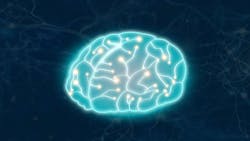Using a novel deep brain stimulation (DBS) device capable of recording brain signals, researchers have identified a pattern of brain activity or “biomarker” related to clinical signs of recovery from treatment-resistant depression. The findings from this small study are an important step towards using brain data to understand a patient’s response to DBS treatment. The study was published in Nature and supported by the National Institutes of Health’s Brain Research Through Advancing Innovative Neurotechnologies Initiative, or The BRAIN Initiative.
The small study enrolled 10 adults with treatment-resistant depression, all of whom underwent DBS therapy for six months. Each participant received the same stimulation dose to begin and then stimulation levels were increased once or twice. Later, researchers used artificial intelligence (AI) tools to analyze collected brain data from six patients and observed a common brain activity signature or biomarker that correlated with patients self-reporting feeling symptoms of depression or stable as they recovered. In one patient, researchers identified the biomarker and were retrospectively able to predict that a patient would fall back into a major depressive episode four weeks before clinical interviews showed they were at risk of a relapse occurring.
In the study, patients received DBS targeting the subcallosal cingulate cortex (SCC), a brain region that regulates emotional behavior and is involved in feelings of sadness. DBS of the SCC is an emerging therapy that can provide stable, long-term relief from depressive symptoms for years. However, using DBS to treat depression remains challenging because each patient’s path to stable recovery looks different. Clinicians also must rely on subjective self-reports from patient interviews and psychiatric rating scales to track symptoms, which can fluctuate over time. This makes it hard to distinguish between normal mood variations and more serious situations requiring a tweak in stimulation. In addition, changes in symptoms in response to DBS can take weeks or months to occur, making it difficult to tell how well the therapy is working.
The patients in the study responded well to DBS therapy; after six months, 90% showed a significant improvement in depression symptoms, and 70% were in remission or no longer depressed. This high response rate was a unique opportunity to look back and examine how each patient’s brain responded differently to the stimulation during treatment.
Christopher Rozell, Ph.D., Julian T. Hightower Chair and professor of electrical and computer engineering at Georgia Tech in Atlanta, and his colleagues used a technique called explainable artificial intelligence to understand these subtle changes in brain activity. The algorithm used brain data to distinguish between depressive versus stable recovery states and was able to explain what activity changes in the brain were the main drivers of this transition. Importantly, the biomarker also distinguished between normal day-to-day transient mood changes and sustained worsening symptoms. This algorithm could provide clinicians with an early warning signal that a patient is moving toward a highly depressive state and requires a DBS adjustment and extra clinical care.
Next, the team analyzed data from MRI brain scans collected from patients before surgery. The results revealed structural and functional abnormalities in the specific brain network targeted by the DBS therapy. More severe white matter deficits were related to longer recovery times.
Researchers also used AI tools to analyze changes in facial expression extracted from videos of participant interviews. In a clinical setting, a patient’s facial expression can reflect the severity of their depression symptoms, a change that psychiatrists likely pick up on in routine clinical evaluations. They found patterns in individual patient expressions that coincided with their transition from illness to stable recovery. This could serve as an additional tool and new behavioral marker to track recovery in DBS therapy. More research is needed to determine whether the video analysis can reliably predict current and future disease states.
Both the observed facial expression changes and anatomical deficits correlated with cognitive states captured by the biomarker, supporting the use of this biomarker in managing DBS therapy for depression.





